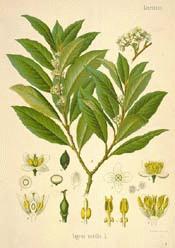
Botanical.com Home Page

|
Sweet Bay
(Laurus nobilis LINN.)
Click on graphic for larger image
|
Laurel (Bay)
Botanical: Laurus nobilis (LINN.)
Family: N.O. Lauraceae
---Synonyms---Sweet Bay. True Laurel. Bay. Laurier d'Apollon. Roman Laurel. Noble Laurel. Lorbeer. Laurier Sauce. Daphne.
---Parts Used---Leaves, fruit, oil.
---Habitat---Shores of the Mediterranean.
---Description---The Sweet Bay is a small tree, growing in Britain to a height of about 25 feet, but in warmer climates reaching as much as 60 feet. The smooth bark may be olive-green or of a reddish hue. The luxurious, evergreen leaves are alternate, with short stalks, lanceolate, 3 to 4 inches long, the margin smooth and wavy. They are thick, smooth, and of a shining, dark green colour. The flowers are small, yellow and unisexual, and grow in small clusters. The shrub has been cultivated in Britain since the sixteenth century. It is the source of the ancients' crowns and wreaths for heroes and poets, and the modern term of 'bachelor,' given for degrees, is probably derived from bacca-laureus, or laurel-berry, through the French bachelier.
The Delphic priestesses are said to have made use of the leaves. It grows well under the shade of other trees if they are not too close, and is useful in evergreen plantations. The leaves are much used in cookery for flavouring. They are often packed with stick liquorice or dried figs. They are used fresh, and may be gathered all the year round.
The volatile oil is sometimes used in perfumery.
The dried, black, aromatic berries come from Provence, Spain, Italy and Morocco. They are ovoid, and the kernel of the seed is loose.
The wood is sweet-scented, and is used for marqueterie work.
Onguent de Laurier is prepared from the oil with axonge and the colouring and scenting principles of the leaves and fruit.
---Constituents---A greenish-yellow volatile oil is yielded by distillation from the leaves which contains a high percentage of oxygenated compounds. The berries contain both fixed and volatile oils, the former, known as Oil of Bays, includes laurostearine, the ether of lauric acid. Laurin can be extracted by alcohol.
A frequent substitute for the expressed oil is said to be lard-coloured with chlorophyll or indigo and turmeric, scented with the berries. Boiling alcohol, which dissolves the true oil, will detect this.
The volatile oil contains pinene, geraniol, eugenol, cineol, etc.
---Medicinal Action and Uses---Leaves, berries and oil have excitant and narcotic properties. The leaves are also regarded as a diaphoretic and in large doses as an emetic.
Except as a stimulant in veterinary practice the leaves and fruit are very rarely used internally. They were formerly employed in hysteria, amenorrhoea, flatulent colic, etc. The berries have been used to promote abortion.
Oil of Bays is used externally for sprains, bruises, etc., and sometimes dropped into the ears to relieve pain. The leaves were formerly infused and taken as tea, and the powder or infusion of the berries was taken to remove obstructions, to create appetite, or as an emmenagogue. Four or five moderate doses were said to cure the ague. The berries were formerly used in several French carminative preparations.
The following products are often mistaken for those of Laurus nobilis.
The fruits of Cocculus Indicus or Anamirta paniculata. They are odourless and kidneyshaped.
The oil of Pimenta Acris, from which bay rum is distilled in the West Indies, and which is also called oil of bay.
The leaves of Prunus Laurocerasus, or Cherry Laurel, to which the name of Laurel is now always applied. The margin of these short, strong serrations at intervals. Caution should be observed in distinguishing these, owing to their poisonous properties.
Common Name Index
A MODERN HERBAL Home Page
Bear in mind "A Modern Herbal" was written with the conventional wisdom of the early 1900's. This should be taken into account as some of the information may now be considered inaccurate, or not in accordance with modern medicine.
© Copyright Protected 1995-2025 Botanical.com
|

